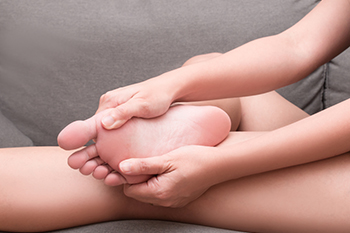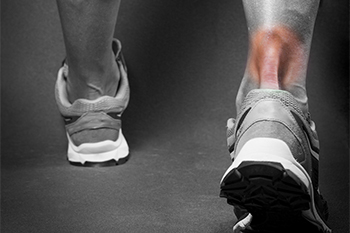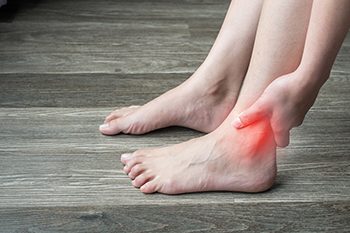Items filtered by date: July 2022
Treating Sesamoiditis

Sesamoiditis is a potentially uncomfortable and painful condition that can threaten the health and vitality of your feet. The condition occurs when the two bones under the big toe joint, known as the sesamoid bones, become inflamed and irritated. This inflammation can occur in response to an injury or chronic causes. If you have sesamoiditis, you can experience a number of different symptoms. Most likely, you will experience pain when conducting weight-bearing activities or when applying pressure to the sesamoid bones. This condition can be painful and irritating, but there are several steps that you can take to mitigate its effects. Firstly, you can wear custom-made orthotics, or shoe inserts, that help you walk without putting pressure on the sesamoid bones. Altering your footwear may also help in reducing pain if you can find a pair of shoes that reduces the amount of pressure you exert on your big toe. In treating your sesamoiditis, you might also try to alter your daily routine to eliminate activities that put excess pressure on the feet and the sesamoid bones. If none of these or other treatments seem to reduce the pain felt from sesamoiditis, a surgical procedure may help provide the needed relief. If you believe that you might have sesamoiditis, it is always best to consult a podiatrist who will be able to properly diagnose your problem and propose a treatment plan.
Sesamoiditis is an unpleasant foot condition characterized by pain in the balls of the feet. If you think you’re struggling with sesamoiditis, contact Sarah Urton, DPM of Kitsilano Foot and Ankle Clinic. Our doctor will treat your condition thoroughly and effectively.
Sesamoiditis
Sesamoiditis is a condition of the foot that affects the ball of the foot. It is more common in younger people than it is in older people. It can also occur with people who have begun a new exercise program, since their bodies are adjusting to the new physical regimen. Pain may also be caused by the inflammation of tendons surrounding the bones. It is important to seek treatment in its early stages because if you ignore the pain, this condition can lead to more serious problems such as severe irritation and bone fractures.
Causes of Sesamoiditis
- Sudden increase in activity
- Increase in physically strenuous movement without a proper warm up or build up
- Foot structure: those who have smaller, bonier feet or those with a high arch may be more susceptible
Treatment for sesamoiditis is non-invasive and simple. Doctors may recommend a strict rest period where the patient forgoes most physical activity. This will help give the patient time to heal their feet through limited activity. For serious cases, it is best to speak with your doctor to determine a treatment option that will help your specific needs.
If you have any questions please feel free to contact our office located in Vancouver, BC . We offer the newest diagnostic and treatment technologies for all your foot and ankle needs.
What Is Charcot-Marie-Tooth Disease?

A congenital condition that affects the peripheral nervous system is called Charcot-Marie-Tooth disease. It occurs as a baby’s DNA begins to develop in the womb, and for that reason is also known as hereditary motor and sensory neuropathy. Charcot-Marie-Tooth is often detected during puberty, causing muscle weakness and difficulty walking. Later on it can also affect the arms and hands. Hammertoes and high arches are further signs of the disease. A child will notice a difficulty in running, a tendency to trip or fall, and a problem lifting the foot at the ankle. Falling may cause injuries to other body parts, making normal daily activities more problematic. If a child begins to drag their feet, has trouble going up and down steps, or marches instead of walking, it is a good idea to consult a podiatrist for an exam and diagnosis. Treatment may include braces to support the foot and certain medications. In some cases, surgery may become an option.
Congenital foot problems require immediate attention to avoid future complications. If you have any concerns, contact Sarah Urton, DPM of Kitsilano Foot and Ankle Clinic. Our doctor can provide the care you need to keep you pain-free and on your feet.
Congenital foot problems are deformities affecting the feet, toes, and/or ankles that children are born with. Some of these conditions have a genetic cause while others just happen. Some specific foot ailments that children may be born with include clubfeet, polydactyly/macrodactyly, and cleft foot. There are several other foot anomalies that can occur congenitally. What all of these conditions have in common is that a child may experience difficulty walking or performing everyday activities, as well as trouble finding footwear that fits their foot deformity. Some of these conditions are more serious than others. Consulting with a podiatrist as early as possible will help in properly diagnosing a child’s foot condition while getting the necessary treatment underway.
What are Causes of Congenital Foot Problem?
A congenital foot problem is one that happens to a child at birth. These conditions can be caused by a genetic predisposition, developmental or positional abnormalities during gestation, or with no known cause.
What are Symptoms of Congenital Foot Problems?
Symptoms vary by the congenital condition. Symptoms may consist of the following:
- Clubfoot, where tendons are shortened, bones are shaped differently, and the Achilles tendon is tight, causing the foot to point in and down. It is also possible for the soles of the feet to face each other.
- Polydactyly, which usually consists of a nubbin or small lump of tissue without a bone, a toe that is partially formed but has no joints, or an extra toe.
- Vertical talus, where the talus bone forms in the wrong position causing other bones in the foot to line up improperly, the front of the foot to point up, and the bottom of the foot to stiffen, with no arch, and to curve out.
- Tarsal coalition, when there is an abnormal connection of two or more bones in the foot leading to severe, rigid flatfoot.
- Cleft foot, where there are missing toes, a V-shaped cleft, and other anatomical differences.
- Macrodactyly, when the toes are abnormally large due to overgrowth of the underlying bone or soft tissue.
Treatment and Prevention
While there is nothing one can do to prevent congenital foot problems, raising awareness and receiving neonatal screenings are important. Early detection by taking your child to a podiatrist leads to the best outcome possible.
If you have any questions please feel free to contact our office located in Vancouver, BC . We offer the newest diagnostic tools and technology to treat your foot and ankle needs.
Achilles Tendon Injuries That Can Affect Athletes

The long tendon that connects the heel bone with the calf muscles is called the Achilles tendon. The Achilles tendon is a critical component in running and walking, making it prone to wear injuries that can affect anyone. However, track and field athletes and those who play volleyball, softball, soccer, or racquet sports are more susceptible to these injuries. Pain in the lower calf, or at the back of the ankle may be indicative of an Achilles tendon injury. A common inflammatory injury to the Achilles tendon is tendonitis, which can cause sudden pain. Paratenonitis is another type of inflammatory issue which causes the covering of the Achilles tendon to thicken and inflame, thereby restricting the tendon’s movement. Tendinosis is a degenerative condition which weakens fibers in the tendon. Insertional Achilles Tendinopathy starts out with an inflammation of tendon fibers that attach to the heel bone, and then later degenerate. Athletes with any of these issues would do well to make an appointment with a podiatrist for proper diagnosis and treatment.
Ankle and foot injuries are common among athletes and in many sports. They can be caused by several problems and may be potentially serious. If you are feeling pain or think you were injured in a sporting event or when exercising, consult with Sarah Urton, DPM from Kitsilano Foot and Ankle Clinic. Our doctor will assess your condition and provide you with quality foot and ankle treatment.
Common Injuries
The most common injuries that occur in sporting activities include:
- Achilles Tendonitis
- Achilles Tendon Rupture
- Ankle Sprains
- Broken Foot
- Plantar Fasciitis
- Stress Fractures
- Turf Toe
Symptoms
Symptoms vary depending upon the injury and in some cases, there may be no symptoms at all. However, in most cases, some form of symptom is experienced. Pain, aching, burning, bruising, tenderness, tightness or stiffness, sensation loss, difficulty moving, and swelling are the most common symptoms.
Treatment
Just as symptoms vary depending upon the injury, so do treatment options. A common treatment method is known as the RICE method. This method involves rest, applying ice, compression and elevating the afflicted foot or ankle. If the injury appears to be more serious, surgery might be required, such as arthroscopic or reconstructive surgery. Lastly, rehabilitation or therapy might be needed to gain full functionality in the afflicted area. Any discomfort experienced by an athlete must be evaluated by a licensed, reputable medical professional.
If you have any questions, please feel free to contact our office located in Vancouver, BC . We offer the newest diagnostic and treatment technologies for all your foot care needs.
Heel Pain Can Be Treated!
Know the Warning Signs of Tarsal Tunnel Syndrome

The tibial nerve is an offshoot of the sciatic nerve at the back of the leg which travels down the leg and eventually passes through a narrow structure in the ankle (the tarsal tunnel). When there is an obstruction within or outside the tunnel that causes the tibial nerve to become pressurized or compressed, this is known as tarsal tunnel syndrome. The symptoms of tarsal tunnel syndrome may occur anywhere along the path of the tibial nerve, including the inside of the ankle and on the bottom of the foot. Symptoms may include tingling or numbness, shooting, sharp pains, burning, pins-and-needles sensations, or electric shocks. Any number of factors may cause the tibial nerve to become pinched, from benign growths within or outside the tarsal tunnel, inflammation from injuries or arthritis, diabetes, flat feet, and more. A podiatrist may treat tarsal tunnel syndrome with anti-inflammatory medications, steroid injections, custom shoes, orthotics, or even surgery in severe cases. It is important to seek treatment from a podiatrist for tarsal tunnel syndrome as failure to repair the nerve may result in permanent nerve damage.
Tarsal tunnel syndrome can be very uncomfortable to live with. If you are experiencing tarsal tunnel syndrome, contact Sarah Urton, DPM of Kitsilano Foot and Ankle Clinic. Our doctor can provide the care you need to keep you pain-free and on your feet.
Tarsal Tunnel Syndrome
Tarsal tunnel syndrome, which can also be called tibial nerve dysfunction, is an uncommon condition of misfiring peripheral nerves in the foot. The tibial nerve is the peripheral nerve in the leg responsible for sensation and movement of the foot and calf muscles. In tarsal tunnel syndrome, the tibial nerve is damaged, causing problems with movement and feeling in the foot of the affected leg.
Common Cause of Tarsal Tunnel Syndrome
- Involves pressure or an injury, direct pressure on the tibial nerve for an extended period of time, sometimes caused by other body structures close by or near the knee.
- Diseases that damage nerves, including diabetes, may cause tarsal tunnel syndrome.
- At times, tarsal tunnel syndrome can appear without an obvious cause in some cases.
The Effects of Tarsal Tunnel Syndrome
- Different sensations, an afflicted person may experience pain, tingling, burning or other unusual sensations in the foot of the affected leg.
- The foot muscles, toes and ankle become weaker, and curling your toes or flexing your foot can become difficult.
- If condition worsens, infections and ulcers may develop on the foot that is experiencing the syndrome.
A physical exam of the leg can help identify the presence of tarsal tunnel syndrome. Medical tests, such as a nerve biopsy, are also used to diagnose the condition. Patients may receive physical therapy and prescriptive medication. In extreme cases, some may require surgery.
If you have any questions please feel free to contact our office located in Vancouver, BC . We offer the newest diagnostic and treatment technologies for all your foot and ankle needs.

